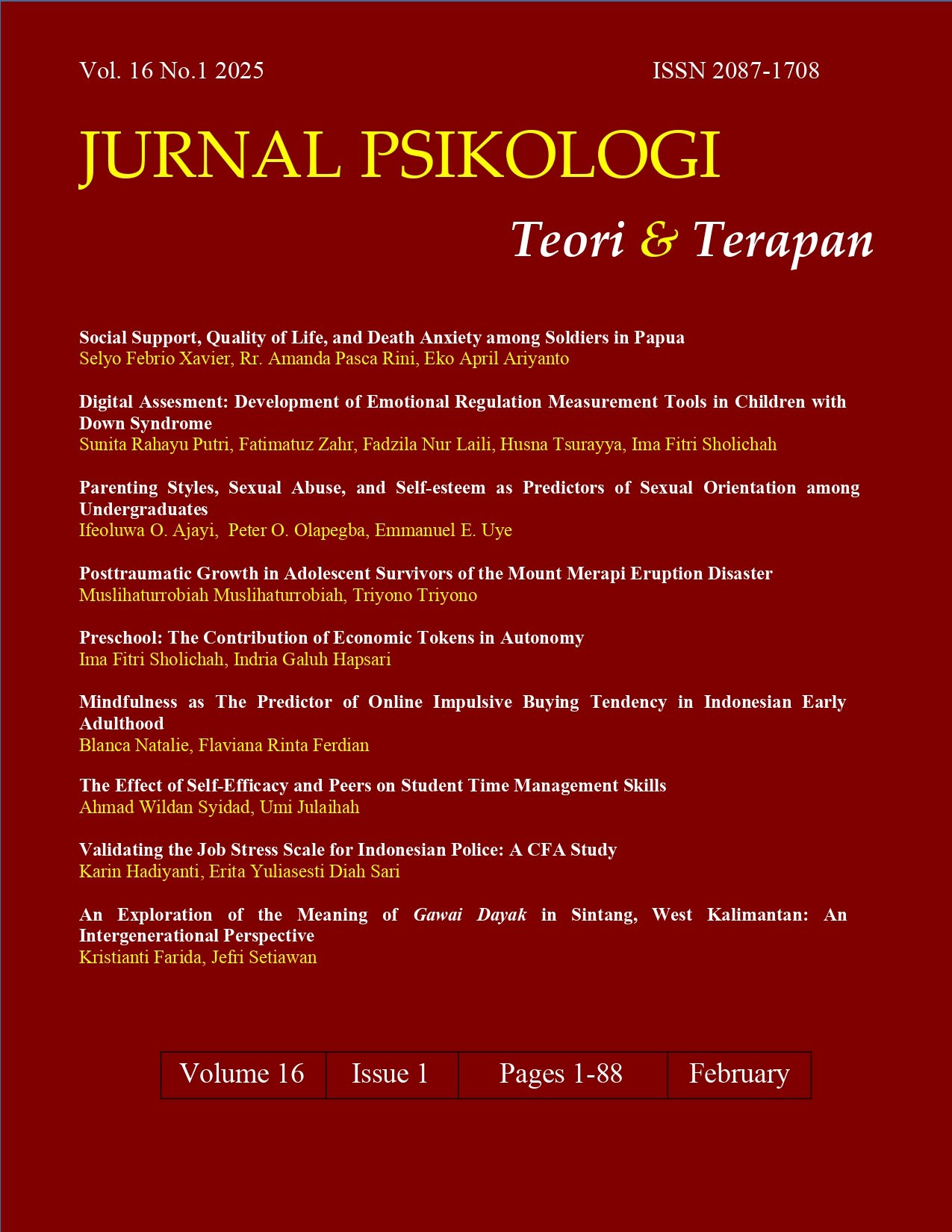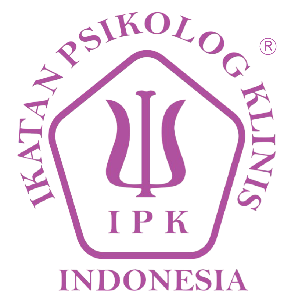Parenting Styles, Sexual Abuse and Self-esteem as Predictors of Sexual Orientation among Undergraduates
DOI:
https://doi.org/10.26740/jptt.v16n01.p18-26Keywords:
Parenting styles, sexual abuse, self-esteem, sexual orientation, undergraduatesAbstract
Background: Sexual orientation has become an emerging issue that affects different populations and cultures in Africa including Nigeria. Studies done on predictors of sexual orientation come with varied results.Objective: This study investigates parenting styles, sexual abuse and self-esteem as likely predictors of sexual orientation among undergraduates in tertiary institutions in Ibadan, Nigeria. Method: Cross-sectional method was adopted while purposive sampling technique was used to select the study population. Data were collected from 472 undergraduates using validated questionnaires and analysed using multiple regressions and independent sample t-test. Two hypotheses were tested and accepted at p =.001 level of significance. Results: The result revealed that parenting styles, sexual abuse and self-esteem jointly predicted sexual orientation among study participants. Moreover, parenting styles, sexual abuse and self-esteem independently predicted sexual orientation among study participants. Conclusion: Parenting styles, sexual abuse and self-esteem are excellent predictors of sexual orientation among study participants. The novelty of this finding is that sexual orientation is less openly discussed among study population.
Keywords: Parenting styles; self-esteem; sexual abuse; sexual orientation; undergraduates
Abstrak
Latar belakang: Orientasi seksual telah menjadi masalah yang muncul yang mempengaruhi populasi dan budaya yang berbeda di Afrika termasuk Nigeria. Studi yang dilakukan pada prediktor orientasi seksual memiliki hasil yang bervariasi. Tujuan: Penelitian ini menyelidiki gaya pengasuhan, pelecehan seksual dan harga diri sebagai prediktor yang mungkin untuk orientasi seksual di kalangan mahasiswa di perguruan tinggi di Ibadan, Nigeria. Metode: Metode cross-sectional diadopsi sementara teknik pengambilan sampel purposif digunakan untuk memilih populasi penelitian. Data dikumpulkan dari 472 mahasiswa dengan menggunakan kuesioner yang telah divalidasi dan dianalisis menggunakan regresi berganda dan uji-t sampel independen. Dua hipotesis diuji dan diterima pada tingkat signifikansi p = .001. Hasil: Hasil penelitian menunjukkan bahwa gaya pengasuhan, pelecehan seksual, dan harga diri secara bersama-sama memprediksi orientasi seksual di antara para peserta penelitian. Selain itu, gaya pengasuhan, pelecehan seksual dan harga diri secara independen memprediksi orientasi seksual di antara peserta penelitian. Simpulan: Gaya pengasuhan, pelecehan seksual, dan harga diri adalah prediktor yang sangat baik untuk orientasi seksual di antara para peserta penelitian. Hal baru dari temuan ini adalah bahwa orientasi seksual kurang didiskusikan secara terbuka di antara populasi penelitian.
Kata Kunci: Gaya pengasuhan; harga diri; mahasiswa; pelecehan seksual; orientasi seksual.
References
Aalsma, M. C., Zimet, G. D., Fortenberry, J. D., Blythe, M. J., & Orr, D. P. (2002). Report of Childhood Sexual Abuse by Adolescents and Young Adults: Stability Over Time. The Journal of Sex Research, 39, 259–263 https://doi.org/10.1080/0022490209552149
Adamczyk, A., & Liao, Y. (2019). Examining Public Opinion about LGBTQ-Related Issues in the United States and Across Multiple Nations. Annual Review of Sociology, 45(1), 401–423. https://doi.org/10.1146/annurev-soc-073018-022332
Abdel-Khalek, A. M. (2016). Introduction to the psychology of self-esteem. In: F. Holloway (Ed.). Self-esteem: Perspectives, influences, and improvement strategies (Pp. 1-13). Nova Science Publishers, Inc.
Ajayi, I. O. (2023). Psychosocial Predictors of Sexual Orientation among Students In Selected Tertiary Institutions in Ibadan Metropolis. MSc Project Submitted to the Department of Psychology, University of Ibadan, Nigeria.
Alhamad, A.M. (2013). 1995-Impact of Childhood Sexual Abuse on Adult Sexual Orientation in a Group of Saudi Males. European Psychiatry, 28(1), 1-12. https://doi.org/10.1016/S0924-9338(13)76932-3
American Psychological Association Resources Page. What is Sexual Orientation? (2023). https://www.apa.org/topics/LGBTQ+/orientation. Accessed March 07, 2025
American Psychological Association (2015). Definitions Related to Sexual Orientation and Gender Diversity. American Psychological Association, Washington, D.C.
Bailey, J. M., Vasey, P. L., Diamond, L. M., Breedlove, S. M., Vilain, E., & Epprecht, M. (2016). Sexual Orientation, Controversy, and Science. Psychological Science in the Public Interest, 17(2), 45-101 https://doi.org/10.1177/1529100616637616
Bailey, J. M. (2009). What is Sexual Orientation and do Women Have one? Nebraska Symposium on Motivation, 54, 43-63 https://doi.org/10.1007/978-0-387-09556-13
Bandura, A. (1997). Self-efficacy: The Exercise of Control. Freeman
Bankole, R.O., Olapegba, P.O., Uye, E. E. (2023). Religiosity, Social Media, and Sexual Orientation as Predictors of Attitude Towards LGBTQ+ Group among Residents in Nigeria. Simulacra, 6(2), 251-262 https://doi.org/10.21107/sml.v6i2.22495
Bridge, L., Smith, P.A., & Rimes, K.A. (2019).Sexual Orientation Differences in The Self-esteem of Men and Women: A Systematic Review and Meta-analysis. Psychology of Sexual Orientation and Gender Diversity. 1-38. https://doi.org/10.1037/sgd0000342
Chan, A. Y. F., Hu, S, Sinclair, J., O’Dwyer, C., Hall, S., Nath, R., & Saewyc, E. (2024). Prevalence of Sexual Minority Adolescents Worldwide: A Systematic Review. Annals of LGBTQ Public &Population Health,5(2), 93-116 https://doi.org/10.1891/LGBTQ-2-23-0005
Capaldi, M., Schatz, J., & Kavenagh, M. (2024). Child Sexual Abuse/Exploitation and LGBTQI+ Children: Context, Links, Vulnerabilities, Gaps, Challenges, and Priorities. Child Protection & Practice, 1-7 https://doi.org/10.1016/j.chipro.2024.100001
Center for Disease Control and Prevention (2018). Definition of Sexual Abuse.www.cdc.com
Cook, C. C. H. (2020). The Causes of Human Sexual Orientation. Theology & Sexuality, 27(1), 1-9 https://doi.org/10.1080/13558358.2020.1818541
Convocar, J.L. & Pios, M. (2019). Students’ Sexual Orientations, Self-esteem, and Problems. JPAIR Multidisciplinary Research, 36(1), 58-75 https://doi.org/10.7719/jpair.v36i1.681
D’ Amico, E., Julien, D., Tremblay, N., & Chartrand, E. (2015). Gay, Lesbian, and Bisexual Youths Coming out to Their Parents: Parental Reactions and Youths’ Outcomes. Journal of GLBT Family Studies, 11(5), 411-437 https://doi.org/10.1080/1550428X.2014.981627
David, N., Ezechi, O., Wapmuk, A., Gbajabiamila, T., Ohihoin, A., Herbertson, E., & Odeyemi, K. (2018). Child Sexual Abuse and Disclosure in South Western Nigeria: a Community Based Study. African Health Sciences, 18(2), 199-208 https://doi.org/10.4314/ahs.v18i2.2
Divya, T.V. & Manikandan, K. (2013). Perceived Parenting Style Scale. Department of Psychology, University of Calicut, Kerala, India.
Eisenberg, M. E., Gower, A. L., Rider, G. N., McMorris, B. J., & Coleman, E. (2019). At the Intersection of Sexual Orientation and Gender Identity: Variations in Emotional Distress and Bullying Experience in a Large Population-Based Sample of U.S Adolescents. Journal of LGBT Youth, 16(3), 235-254 https://doi.org/10.1080/19361653.1567435
Francis, A., Pai, M., & Badagabettu, S. (2020). Psychological Well-being and Perceived Parenting Style among Adolescents. Comprehensive Child & Adolescent Nursing, https://doi.org/10.1080/24694193.2020.1743796
Hill, P. L., Reesor, N., & Collict, D. (2017). Sexual Identity. In K. L. Nadal (Ed.). The SAGE Encyclopedia of Psychology and Gender, pp 1521-1523 http://dxi.doi.org/10. 4135/9781483384269.n510
Hill, A. O., Bourne, A., McNair, R., Carman, M., & Lyons, A. (2020) Private Lives 3: The Health and Wellbeing of LGBTIQ People in Australia. Melbourne: La Trobe University https://www.latrobe.edu.au/arcshs/publications/private-lives/private-lives-3
Kuppens, S., & Ceulemans, E. (2018). Parenting Styles: A Closer Look at a Well-known Concept. Journal of Child and Family Studies. https://doi.org/10.1007/s10826-018-1242-x.
Martina, S. (2022). LGBTQ+Q in Africa: Stigma, Attacks, and Criminal Charges. Human Rights Africa.
Masud, H., Ahmad, M.S., Cho, K.W., & Fakhr, Z.(2019). Parenting Styles and Aggression among Young Adolescents: A Systematic Review of Literature. Community Mental Health Journal, 55(6), 1015-1030 https://doi.org/10.1007/s10597-019-00400-0
Mills-Koonce, W. R., Rehder, P. D., & McCurdy, A. L. (2018). The Significance of Parenting and Parent-child Relationships for Sexual and Gender Adolescents. Journal of Research on Adolescence, 28(3), 637-649 https://doi.org/10.1111/jora.12404
Moser, C. (2016). Defining Sexual Orientation. Archives of Sexual Behavior, 45(3), 505-508 https://doi.org/10.1007/s10508-015-0625-y
Nwaubani, A. (2017). LGBTQ+ Acceptance Slowly Grows in Nigeria, Despite Anti-Gay Laws. Reuters. https://www.reuters.com/article/us-nigeria-LGBTQ+-survey/LGBTQ+-acceptance–slowly-grows-in-nigeria-despite-anti-gay-laws-idUSKCN18C2T8.
Office for National Statistics (2023). Statistical Bulletin, Sexual Orientation, UK: 2021 and 2022 www.ons.gov.uk
Okanlawon, K. (2021). Homophobic Bullying in Nigerian Schools: The Experiences of LGBTQ+ University Students. Journal of LGBT Youth 14(1), 51-70 https://doi.org/10.1080/19361653.2016.1256244
Olga, G., Vladislav, K., & Anastasia, S. (2021). Gender Identification and Attitudes Toward Gay People: Gender and Sexuality Differences and Similarities. Curr Psychol 42, 7197-7210. https://doi.org/10.1007/s12144-021-02050-6
Rosenberg. M. (1965). Society and the Adolescent Self-image. Princeton University Press.
Rosario, M., Schrimshaw, E. W., & Hunter, J. (2014). Predictors of Sexual Orientation Group Differences in Female-to-male Transsexuals. Archives of Sexual Behaviour, 43(3), 467-475 https://doi.org/10.1037/14193-018
Shongwe, M. C., Chung, M. H., Chien, L-Y., & Chang, P. C. (2021). Does Parenting Styles Moderate The Relationship between Parent-Youth Sexual Risk Communication and Premarital Sexual Debut among In-School Youth In Eswatini? PloS One, 16(1):e0245590 https://doi.org/10.1371/journal.prone.0245590
Skorska, M. N., Coome, L. A., Peragine, D. E., Aitken, M., & VanderLaan, D. P. (2021). An Anthropometric Study of Sexual Orientation and Gender Identity in Thailand. Scientific Report, 11, 1-12, 18432 https://doi.org/10.1038/s41598-021-97845-9
Strömdahl, S., Williams, A. O., Eziefule, B., Emmanuel, G., Iwuagwu, S., Anene, O., Orazulike, I., Beyrer, C., & Baral, S. (2019). An Assessment of Stigma and Human Right Violations among Men Who Have Sex with Men in Abuja, Nigeria. BMC International Health and Human Rights, 19(1). https://doi.org/10.1186/s12914-019-0190-x
Suen, L. W., Lunn, M. R., Katuzny, K., Finn, S., Duncan, L., Sevelius, J., Flentje, A., Capriotti, M. R., Lubensky, M. E., Hunt, C., Weber, S., Bibbins-Domingo, K., & Obedin-Maliver, J. (2020). What Sexual and Gender Minority People Want Researchers to Know about Sexual Orientation and Gender Identity Questions: A Qualitative Study. Archives of Sexual Behavior, 49(7), 2301–2318 https://doi.org/10.1007/s10508-020-01810-y
Tannenbaum, I. J. (2006). The Impact of Social Context on the Conceptualization of Sexual Orientation: A Construct Validity Investigation. PhD Thesis Submitted to the Graduate School, The Ohio State University
Ukah, A. (2018). Pentecostal Apocalypticism: Hate Speech, Contested Citizenship, and Religious Discourses on Same-Sex Relations in Nigeria. Citizenship Studies, 22(6), 633-649 https://doi.org/10.1080/13 621025.2018.1494906
Uye, E. E., Ezeh, P. N., & Olapegba, P. O. (2023). Parental Perception of Child Behavior and Parental Abuse as Predictors of Delinquent Behavior among Adolescents in a Military Cantonment in Ibadan, Nigeria. Philippines Social Science Journal, 6(3), 19-26 https://doi.org/10.52006/main.v6i3.780
Wang, Y., Wu, H., & Sun, Z. (2019). The Biological Basis Of Sexual Orientation: How Hormonal, Genetic, and Environmental Factors Influence to Whom We Are Sexually Attracted. Frontiers in Neuroendocrinology https://doi.org/10.1016/j.yfrne.2019.100798
Xu, Y. & Zheng, Y. (2015). Does Sexual Orientation Precede Childhood Sexual Abuse? Childhood Gender Nonconforming as a Risk Factor and Instrumental Variable Analysis. Sexual Abuse: A Journal of Research & Treatment,29(8), 786-802 https://doi.org/10.1177/1079063215618378
Downloads
Published
How to Cite
Issue
Section
License
Copyright (c) 2025 Ifeoluwa O. Ajayi Ajayi, Emmanuel E Uye, Peter O. Olapegba

This work is licensed under a Creative Commons Attribution 4.0 International License.
Authors who publish in this journal agree to the following terms:
Copyright in any article is held by the author.
The author grants the journal, publication rights with the work simultaneously licensed under a Creative Commons Attribution License that allows others to share the work with an acknowledgment of the work's authorship and initial publication in this journal.
Authors may enter into separate, additional contractual arrangements for the non-exclusive distribution of the journal's published version of the work (e.g., posting it to an institutional repository or publishing it in a book), with an acknowledgment of its initial publication in this journal.
Authors are permitted and encouraged to post their work online (e.g., in an institutional repository or on their website) prior to and during the submission process, as this can lead to productive exchanges, as well as earlier and greater citation of published work.
 Abstract views: 406
,
Abstract views: 406
, PDF Downloads: 307
PDF Downloads: 307


















